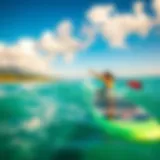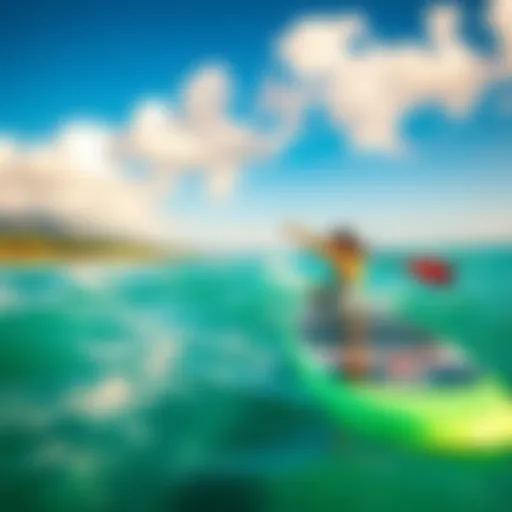DIY Foil Board Construction: A Complete Guide
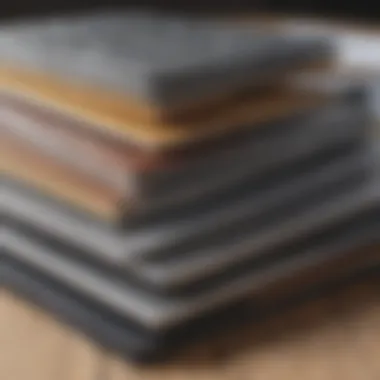

Intro
Making your own foil board can be an exciting adventure, especially for kiteboarding enthusiasts. There’s a certain magic that comes with taking raw materials and crafting something that suits your individual riding style. In this guide, we will traverse the essential steps in constructing a custom foil board, covering everything from selecting the right materials to ensuring optimal performance on water.
The creation of a foil board is not just about the final product; it’s about diving into the nuances of design and engineering, tailoring every aspect to your preferences, and fully understanding the technical implications. There’s also the real thrill of riding a board that you made yourself. Whether you're a beginner looking to dip your toes into this craft or a seasoned kiteboarder searching for that perfect edge, this comprehensive guide serves as your blueprint.
Let’s explore the fundamental techniques involved in kiteboarding to ensure a deeper understanding of how your custom foil board will interact with the elements.
Understanding Foil Boarding
Foil boarding, an exhilarating and dynamic sport, has captured the attention of many thrill-seekers over the years. Understanding foil boarding is crucial because it lays the foundation for constructing a successful and performance-optimized foil board. For kiteboarding enthusiasts, mastering this knowledge can make all the difference between gliding smoothly above the water or sinking in frustration.
In essence, foil boarding involves riding atop a specially designed board connected to a submerged hydrofoil, which lifts the board out of the water as speed increases. This unique combination significantly reduces drag and allows for a smoother ride, even in choppy conditions. Grasping the fundamentals of hydrofoil technology helps enthusiasts appreciate the amazing engineering that makes this sport possible.
The Basics of Hydrofoil Technology
Hydrofoil technology revolves around the principle of lift, much like an airplane wing. When the board accelerates, the hydrofoil creates a difference in pressure above and below the wing, resulting in lift that elevates the board above the water surface. This results in decreased additional resistance, providing a quieter, more stable ride.
Having a grasp of hydrofoil construction can significantly enhance a rider's performance and comfort. For instance, the angle of attack, width, and shape of the foil all influence performance characteristics, altering speed and maneuverability. Different foiling setups cater to specific styles and conditions, so familiarity with these dynamics can guide riders in making informed choices during construction or upgrades.
Also, understanding hydrofoil materials—like aluminum, carbon fiber, or even plastic—can empower builders to choose materials that maximize their board's performance. A more rigid and lighter hydrofoil provides an edge in speed, while durable options are often favored for stability.
Benefits of Using a Foil Board in Kiteboarding
Creating your own foil board can be rewarding for several reasons that cater to both performance and personal satisfaction.
- Increased Performance: By using a foil board, kiteboarders can achieve higher speeds while expending less energy. The reduced drag not only makes for faster rides but allows riders to glide effortlessly over choppy water, minimizing fatigue.
- Versatility: Foil boards open up new possibilities for riding in various conditions. Unlike traditional boards that struggle in lighter winds or rough water, foil boards can lift off and maintain speed even when conditions seem lackluster.
- Enhanced Learning Curve: Riders who start with foil boarding often experience a quicker learning curve. When they’re elevated above the water, they can gain better balance and control, encouraging more rapid skill development.
- Custom Experience: Constructing a foil board gives kiteboarders the freedom to express their individuality. Each builder can customize dimensions, materials, and hydrodynamics to match their riding style, ensuring a personal touch in performance.
"Understanding the nuances of foil boarding opens up a world of possibilities and elevates your riding experience."
Material Selection for Your Foil Board
When tackling the DIY project of constructing your own foil board, a solid understanding of material selection is key. Not only does it influence the performance of your board, but it also contributes to its longevity and ease of handling. Choosing the right materials involves assessing their functionality, weight, and durability, all of which play vital roles in your kiteboarding experience. Lighter materials may offer ease of maneuverability, while sturdier options can provide better stability during rides.
A foil board is exposed to salty water, harsh winds, and sometimes rugged conditions, all of which can take a toll on its materials. Hence, it’s imperative to select components that can withstand these elements. A well-thought-out approach to material selection not only ensures effective performance on the water but also your safety as you ride.
Choosing the Right Base Materials
The foundation of your foil board typically consists of either foam or wood, with each material offering its own advantages. Foam is lightweight, facilitating better buoyancy, which is crucial for early rises in the water. For example, a density of around 20 kg/m³ ensures that your board stays afloat while still providing enough strength.
On the other hand, wood tends to be denser and can offer more stability. A birch plywood, for instance, has great structural integrity, which can be important when the waves get choppy.
A few other options to consider include:
- EPS (Expanded Polystyrene): Commonly used for its light weight and affordability.
- XPS (Extruded Polystyrene): Provides better water resistance compared to EPS.
- Sandwich constructions: Combining materials for added strength without overly increasing weight.
Ultimately, the choice boils down to a balance between weight and strength, tailored to your individual riding style and the conditions you usually encounter.
Foil Components and Their Impact on Performance
The foil itself is a complex system of components, and they all contribute significantly to riding efficiency. The three major elements of any hydrofoil are the mast, wings, and fuselage.
- Mast: This vertical member connects the board to the wings. The height and stiffness of the mast influence stability while riding. A longer mast may be beneficial for deeper water, but it also increases drag.
- Wings: The key to lift and drag reduction. Larger wings can generate more lift, making it easier to get up on the foil, but they may be less efficient at high speeds. Conversely, smaller wings operate better at speed and can improve maneuverability but require more precise control.
- Fuselage: This part connects the mast to the wings, and its length can affect turning radius and overall responsiveness.
A cohesive design with proper dimensions for these elements can mean the difference between a smooth ride and one that feels more like wrestling with a ski boat.
Remember, the effectiveness of your foil board stems from the synergy between all its components; no part can outshine the others without the right fit.
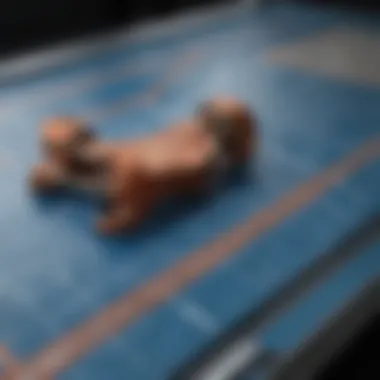

Understanding these components' roles allows for informed decision-making during the construction process, ensuring that the board aligns with your performance targets and personal style. With the right materials and component choices, you will be one step closer to mastering the waves.
Design Principles for DIY Foil Boards
When embarking on the journey of crafting your own foil board, understanding the design principles becomes paramount. These principles not only influence the performance of your board on the water but also align with your individual riding style. A well-planned design can enhance stability, ease of maneuverability, and even your overall enjoyment while kiteboarding. The goal is to create an efficient board that meets your specific needs, making this section a key part of the comprehensive guide.
Board Shape and Size Considerations
The shape and size of your foil board play crucial roles in how it will handle different water conditions and riding styles. When considering these factors, it’s important to think about the following:
- Length: Typically, longer boards provide greater stability and a smoother ride, especially in choppy waters. If you're an advanced kiteboarder looking to perform agile maneuvers, a slightly shorter board might suit you better.
- Width: A wider board gives more surface area, offering increased lift and stability. However, it can also make the board feel bulkier on turns. Finding a balance is key.
- Rockers: The rocker refers to the curve of the board from nose to tail. A flatter rocker enhances speed, while a pronounced curve can improve maneuverability at the cost of some speed.
- Tail Shape: Different tail shapes can significantly influence the board's performance. For instance, a squared tail can provide more grip while turning; conversely, a rounded tail may excel in speed and would be better for freeride sessions.
Choosing the appropriate shape and size requires some introspection about your riding style. If you favor grounded tricks and aggressive jibes, narrower and shorter designs may be your lane. Alternatively, if you're inclined towards leisurely cruising, a more stable and wider board might be in order.
Understanding the Foil Positioning
Foil positioning is another design element that significantly impacts how your board performs. The placement of the foil under the board can alter the balance and lift dynamics while riding. Here are some specifics to note:
- Forward vs. Aft Positioning: Positioning the foil closer to the front of the board (forward) generally increases lift and can assist with takeoffs. Conversely, moving it toward the back (aft) enhances control and can smooth out your ride when conditions get rough.
- Height: The height at which the foil is mounted also merits consideration. A higher mount increases control and can make it easier to pop out of the water, while a lower mount offers stability but might feel less responsive.
- Angle: The angle of attack is crucial; it affects how much lift the foil generates. Too high of an angle might lead to porpoising (where the board constantly pushes down and back up), while too low could hinder lift.
Ultimately, understanding these facets aids in sculpting a board that’s tailored to give you the perfect balance of performance and enjoyment, whether you’re just starting out or looking to push your boundaries further. The variations are plenty, and through careful design considerations, you’ll find what works best for you.
"The joy of kiteboarding lies not just in the adventure but also in the precision of a well-crafted board; crafting it is half the thrill."
In summary, investing time in understanding the board shape, size, and foil positioning can dramatically influence your kiteboarding experience. By meticulously evaluating these design principles, you’re not merely constructing a board; you’re crafting a unique riding adventure that reflects your individual style and preferences.
Step-by-Step Construction Process
When embarking on a journey to create your own foil board, understanding the step-by-step construction process is crucial. This phase overlays everything else mentioned previously and brings the theoretical aspects into practical application. Constructing your board allows you to tailor it to your personal riding preferences and conditions, ensuring an optimized experience on the water. Moreover, this process demystifies the craft, turning what might feel like a daunting task into an attainable project. Everyone from seasoned kiteboarders to newcomers will find value in the specifics provided here, enhancing their engagement with the sport.
Preliminary Planning and Tools Needed
Before diving headfirst into the act of construction, laying out a solid plan is the first order of business. Planning helps avoid mistakes and ensures that you have everything at hand before you start. To kick things off, begin by gathering your materials and tools. Here’s what you’ll generally need:
- Materials:
- Tools:
- Plywood or epoxy foam for the board
- Aluminum or carbon fiber for the foils
- Resin and hardener for sealing everything up
- Saw (circular or jigsaw) for cutting material
- Router for smooth edges
- Sandpaper or a sander for finishing
- Drill for holes and fittings
Once equipped with these essentials, sketch a design plan. This blue-print isn’t fixed but will guide you through the cutting and assembling stages. Remember, having a clear image of your desired board will save you time and effort later, as they say, ‘measure twice, cut once.’
Cutting and Shaping Your Board
Now comes the fun part—cutting and shaping! Here, the vision materializes into a physical object. Following your design plan, begin cutting the materials into the desired shape of your board. It’s often recommended to start out with a larger board than needed; you can always trim it down to your preferred size.
- Shaping Tips:
- Ensure all cuts are straight, as uneven edges can impact performance.
- Use a router to round the corners and edges, which helps in preventing any snagging or catching when you’re riding
Once the basic shape is cut, take your time with sanding. This step is more crucial than many imagine. Sanding the edges well ensures a smooth finish, reducing the risk of splinters and enhancing the overall appearance of your foil board.
Assembling the Foil and Board
After achieving a well-shaped board, it’s time for assembly. This phase is where the hydrofoil components get attached to your board. The positioning of the foil can influence the overall performance and riding style, so this deserves meticulous attention.
- Marking Position:
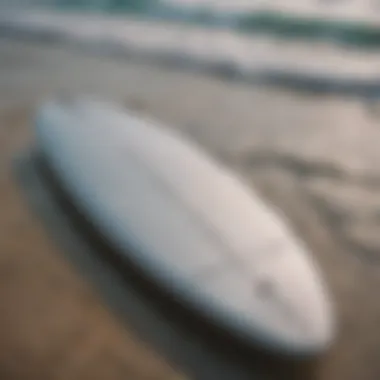

- Mark the spots for the foil mounts based on your design. A common practice is to place the foil around 40% back from the nose of the board, but personal preference plays a significant role here.
- Drilling Holes:
- Carefully drill holes for the attachment screws. A power drill is your best friend here, and ensuring the holes are straight can help avoid any structural weaknesses later.
- Securing the Foil:
- Attach the foils using the screws, ensuring everything is tightened but not overdone. Over-tightening can risk cracking materials.
Finishing Touches and Safety Measures
The final stage is like applying icing on a cake—essential yet often overlooked. Here’s where you ensure everything is smooth and ready for the water.
- Sealing:
- Safety Checks:
- Use an epoxy resin to seal the board. This step not only enhances waterproofing but also provides a shiny finish.
- Ensure no sharp edges remain; run your hand along all edges to check for rough spots. If found, sand them down.
- Consider using a leash or any safety device as a precaution when testing your board on water.
By paying attention to these details, you’ll not only craft a board but also maintain safety during your exhilarating adventures in kiteboarding. As the saying goes, "A stitch in time saves nine"—taking the time to ensure quality now will pay off dividends later in performance and longevity of your new foil board.
Testing and Optimizing Your DIY Foil Board
Once you've crafted your foil board, the next crucial step is to test and optimize it. This phase is paramount, as it ensures that the board performs to its potential in real-world conditions. You’ve poured time and effort into construction, so understanding its capabilities can be the difference between a thrilling ride and a frustrating flop.
Proper testing not only validates your design choices but also allows for adjustments that can significantly enhance performance. This process is an iterative one; it often involves trial and error, which can lead you to make informed modifications to fine-tune the board based on your riding style and preferences.
Initial Water Tests and Performance Analysis
When you dip the board into water for the first time, it’s like opening a gift—you are both anxious and excited. Start in conditions that you’re comfortable with; flat water will often allow you to focus purely on the board’s behavior. Pay close attention to how it tracks and lifts.
- Lift-off: Observe how easily the board rises out of the water. A well-constructed foil board should lift smoothly with minimal resistance. If you find that it’s sluggish, the foil positioning or design elements might need tweaking.
- Stability: As you ride, assess the balance. Does it feel steady beneath your feet, or is it wobbling? Wobbling could indicate that the board's shape or foil positioning isn’t optimal.
- Speed Control: Test how it responds to your movements. Is it intuitive, or do you feel like you're constantly compensating? Good speed control can greatly enhance your confidence on the water.
Take notes on these aspects during your initial tests. It’s often useful to have a friend along to record observations, as sometimes you might not notice issues right away.
Adjustments and Fine-Tuning for Best Results
After your initial tests, it’s time to roll up your sleeves to make any necessary adjustments. Think of this as tuning a musical instrument; every small change might unlock a fuller sound (or in this case, a better ride).
- Foil Positioning: Experiment with the placement of the foil on the board. A slight shift can radically affect the lift and handling. Moving it forward usually increases speed but can reduce stability. Conversely, pushing it back may improve stability at the cost of lift.
- Board Shape Modifications: If you don’t feel fully confident, consider reshaping certain sections of the board. Sometimes just tweaking the tail or nose can make all the difference.
- Weight Adjustments: Adding or removing weight—whether by modifying the board itself or altering your gear—can impact how the board performs under various conditions.
Once these adjustments are made, it’s back to the water for another round of tests. Keep this cycle going until you reach a level of performance that makes you smile. Remember, no two riders are alike, and what works for one could be entirely different for another. Embrace the trial-and-error aspect of the process to hone in on your ideal setup.
"The finest details are the essence of simplicity and elegance." – Johann Wolfgang von Goethe
By investing the time to test and optimize your board, you're not just enhancing performance; you're personalizing your kiteboarding experience, tailoring it to fit your exact needs and style.
Maintenance and Care for Your Foil Board
Routine maintenance and proper care are the backbone of longevity and performance in any foil board. Kiteboarding is thrilling, yet the elements can be harsh. Saltwater, sand, and UV rays are relentless foes that can wear down your carefully constructed board over time. By implementing regular maintenance practices, you not only preserve the integrity of your equipment but also ensure optimal performance on the water.
Investing time in taking care of your foil board is akin to nurturing a fine instrument; the better you look after it, the more it will reward you with a smooth ride. Understanding the importance of this aspect is essential for those who wish to enjoy the waves without a hitch.
Routine Checks and Repairs
Establishing a routine for checks and repairs is crucial for maintaining your foil board’s performance. Here are some key aspects to focus on:


- Inspect the Board for Cracks: Regularly examine the board's surface for any signs of cracks or damage. Even small imperfections can lead to bigger problems if left unchecked.
- Foil Check: Examine the foil for any bends or deformations. It’s important that it maintains its shape to ensure stable riding. Remember, a foil that’s out of whack can throw off your balance.
- Hardware Tightness: Screws and nuts holding your foil components need to be tightly secured. During each session or at least weekly, check to ensure they haven’t loosened up. A good tip is to apply some thread locker to prevent loosening.
- Wash it Off: After every use in saltwater, rinse off the board and foil components with fresh water. Salt can corrode and damage materials; this simple act can greatly increase longevity.
- Plan for Repairs: If you spot any issues, like a small crack, take action promptly. Use appropriate repair kits designed for materials like fiberglass or carbon. Addressing problems when they’re small saves you considerable headaches down the line.
Taking the time to methodically check and repair your board ensures that your investment lasts longer and performs better, making those rides much smoother.
Storage Tips for Longevity
Where and how you store your foil board can have significant effects on its condition over time. Here are some practical storage tips to consider:
- Keep It Indoors: When not in use, store your board in a cool, dry place. Exposure to direct sunlight can lead to fading and weakening of materials.
- Use a Board Bag: Investing in a high-quality board bag can act as an extra layer of protection against scratches, dings, and UV light. It’s worth the initial price for the peace of mind.
- Avoid Stacking: If you have multiple boards, avoid stacking them on top of each other without proper padding. The weight and pressure can lead to warping or damage.
- Temperature Control: Extreme temperatures, whether too hot or too cold, can be damaging. Try to keep your board in a stable environment where the temperature is moderate.
- Hydration is Key: If you're storing your board for an extended period, consider wiping it down with a damp cloth before you tuck it away. This helps to reduce any salt or residue that may lead to corrosion later.
Taking good care of your foil board transcends mere maintenance; it’s about the joy of kiteboarding without the worry of equipment failure.
By applying these simple routine checks and mindful storage tips, you’ll ensure that the board you crafted with care will continue to give you the thrill of the ride time after time.
Community and Resources for DIY Foil Board Builders
Building your own foil board is not just a solitary endeavor; it’s a journey best traveled with others. The topic of community and resources holds significant weight in this article, because the collective wisdom, advice, and support from fellow enthusiasts can rally your DIY project from concept to completion. Engaging with others who share your passion enhances the learning experience and often sparks innovative ideas that one might not think of alone. Additionally, by partaking in these networks, you tap into a wealth of experience that can guide you in overcoming challenges that arise during the construction process.
Looking into support systems such as online forums and local groups not only allows for the exchange of knowledge but also builds relationships. Collaborating with others can lead to shared resources, including the latest tools, materials, and techniques. It also ensures that as you venture into constructing your foil board, you're not navigating this shipwreck alone.
Online Forums and Groups for Collaboration
Diving into the world of online forums and social media groups, kiteboarding enthusiasts can find a treasure trove of information and camaraderie. Examples include platforms like Reddit and specific Facebook groups dedicated to kiteboarding and DIY projects. These spaces allow users to share not only their triumphs but also their trials. When faced with sticking points, asking a question in one of these online communities can yield a plethora of responses. Here, the collective wisdom shines brightly as experienced builders offer tips and solutions.
Furthermore, seeing photos and detailed accounts from others who went down a similar path can serve as motivation. You can explore different design ideas or construction methods and then tailor them to your own style and preferences. In these forums, you might also find local meet-ups, which can create opportunities to physically collaborate or simply enjoy a day at the beach with like-minded individuals.
Recommended Suppliers and Tool Providers
Finding the right materials and tools is crucial in crafting a foil board that meets your specifications. It's essential to know where to source the best supplies, and fortunately, a multitude of reliable suppliers cater to DIY builders. Online platforms often offer not just materials but also comprehensive guides that help in the selection process. Websites like West Marine or even specialty kiteboarding retailers can be excellent starting points.
You can also check out local hardware stores for wood or composite materials, and they might have insights on which products are best for your project. In some cases, dedicated kiteboarding shops can provide specialized equipment, ensuring you avoid the pitfalls of selecting unsuitable items.
Research the reputation of suppliers within your community, seeking recommendations from fellow builders on forums or social media. Engaging with trusted partners helps build a solid foundation for your project.
"An informed builder is a successful builder. Use the community to enhance your journey."
In summary, leveraging communal knowledge and reliable supplier networks is key to developing a durable, high-performance foil board. Whether you seek advice from experienced kiteboarders or rely on quality materials from respected manufacturers, the resources available can significantly enhance your board-building experience.
Exploring Innovations in Foil Board Design
As kiteboarding evolves, so does the technology behind foil boards. It’s not just about catching waves anymore; it’s about how well you can cut through the water, glide with ease, and truly harness the wind. In this section, we will delve into how innovations in foil board design are shaping the future of the sport and why these advancements are crucial for both performance and enjoyment on the water.
Emerging Trends in Materials and Shapes
When it comes to materials, kiteboarding enthusiasts are finding exciting alternatives that not only enhance durability but also affect performance. Lightweight options like carbon fiber or high-density foam allow for agile maneuvering while maintaining structural integrity. Traditionally, wood and fiberglass were the go-to, but as composite materials develop, you’ll find these being replaced by lighter, stronger choices.
- Carbon Fiber: Known for its strength-to-weight ratio, carbon fiber boards provide stiffness without excessive weight, resulting in quicker response times and better control.
- High-Density Foam: This material reduces overall weight and offers enhanced buoyancy, making it easier for riders to lift off the water.
- Hybrid Designs: Many boards now incorporate a mix of these materials, allowing for tailored performance, depending on the rider's needs.
In terms of shapes, the trend is moving towards more defined outlines that improve aerodynamics. The curvature of a foil board can drastically change its dynamics on the water. Riders are increasingly exploring:
- Wider Nose: Enhances lift, especially during take-off, ideal for those who prefer a smoother ride.
- Narrower Tail: Increases speed while providing greater control during sharp turns.
The combination of these innovative materials and shapes offers the potential to craft a board tailored to individual riding styles, opening doors to greater personalization.
"Innovation is the key to staying ahead in kiteboarding. A well-designed board can not only enhance performance but also increase overall enjoyment."
Future of Custom Foil Boards in Kiteboarding
Looking ahead, we can expect the custom foil board market to grow significantly as technology continues to advance. Innovations such as 3D printing are beginning to play a pivotal role in board design, allowing for bespoke shapes that were once only a dream. This means:
- Personalization: Riders can customize not just the aesthetics but also the performance features of their boards, ensuring they match their style and preference perfectly.
- Rapid Prototyping: Riders or small brands can develop and test new designs quickly, reducing the time it takes to bring a new idea to the water.
- Sustainability: As the sport steers towards eco-friendliness, we may see a shift towards using recycled materials or biodegradable options, reshaping the environmental impact of kiteboarding.
The potential for new advancements in foil technology is immense. With continued interests in performance and personalization, the future of custom foil boards promises to keep pushing the boundaries, ensuring that kiteboarders have the tools they need to elevate their experience to new heights.
As kiteboarding keeps evolving, so does the understanding of what makes for the best board. By embracing the latest innovations, builders and riders alike can ensure they’re riding at the forefront of what this thrilling sport has to offer.






